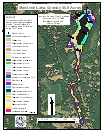Manitook Lake, Granby
2004 Aquatic Plant Survey Map of Manitook Lake
Manitook Lake is naturally fed by a stream that enters at the north end after running through an active sand and gravel pit. Water flows out of the lake through the long, shallow channel to the south. A now-closed municipal landfill sits on a wooded slope above the east side of the lake, and homes have been built on the western side. Residents in this area are members of a lake association that prohibits public use of the lake but permits boating, including use of boats with motors. Association members have been concerned that aquatic plants could interfere with recreational use of the lake and asked that it be surveyed in 2004. One resident said septic systems serving homes on the west side of the lake may be inadequate and that lawn fertilizer may raise nutrient levels in the lake water above natural levels. The 56.9-acre Manitook Lake supports a diverse community of aquatic plants, including at least 23 species. No single species was dominant, but many species were abundant.
Most abundant in the main body of the lake were Robbins' pondweed (Potamogeton robbinsii), spineless hornwort (Ceratophyllum echinatum), eelgrass (Vallisneria americana), and southern naiad (Najas guadalupensis). In the southern end of the lake, southern naiad was most abundant, and white water lily (Nymphaea odorata) grew abundantly along the sides. Less abundant species in the southern part of the lake were yellow water lily (Nuphar variegata), western waterweed (Elodea nuttallii), little floating heart (Nymphoides cordata), spineless hornwort, eelgrass, large-leaf pondweed (Potamogeton amplifolius), and Robbins' pondweed. Both white water lily sub-species, Nymphaea odorata spp. odorata and spp. tuberosa, occurred on the west side of this area.
The northern end of the lake was less diverse. Spineless hornwort was most abundant although it was found primarily in small patches. White water lily was most abundant in shallow water along the edges. An invasive species, variable-leaf watermilfoil (Myriophyllum heterophyllum), occurred in large patches in this area, as did eelgrass, western waterweed, large-leaf pondweed, and invasive curlyleaf pondweed (Potamogeton crispus). Smaller patches or individual plants of humped bladderwort (Utricularia gibba) and southern naiadalso were recorded. Several patches of slender watermilfoil (Myriophyllum tenellum), a species of special concern in Connecticut, were recorded in this area as well, forming a thick carpet in water 2 m deep in one location.
The bottom drops steeply on the lake’s east side; no floating-leaved species occurred in the area, and submerged species occurred more sparsely than in other parts of the lake. Eelgrass and spineless hornwort were most abundant, and Robbins' pondweed occurred in deeper water. Much of the middle of the lake was too deep to sample.
A narrow channel flowing from the southern end of the lake supported dense populations of variable-leaf watermilfoil, with white water lily, watershield (Brasenia schreberi), and yellow water lily along the sides of the channel. Smaller patches or individual plants of western waterweed, spineless hornwort, large-leaf pondweed, Robbins' pondweed, small pondweed (Potamogeton pusillus), ribbon-leaf pondweed (Potamogeton epihydrus), southern naiad, eelgrass, common bladderwort (Utricularia macrorhiza), and purple bladderwort (Utricularia purpurea) also were recorded.


